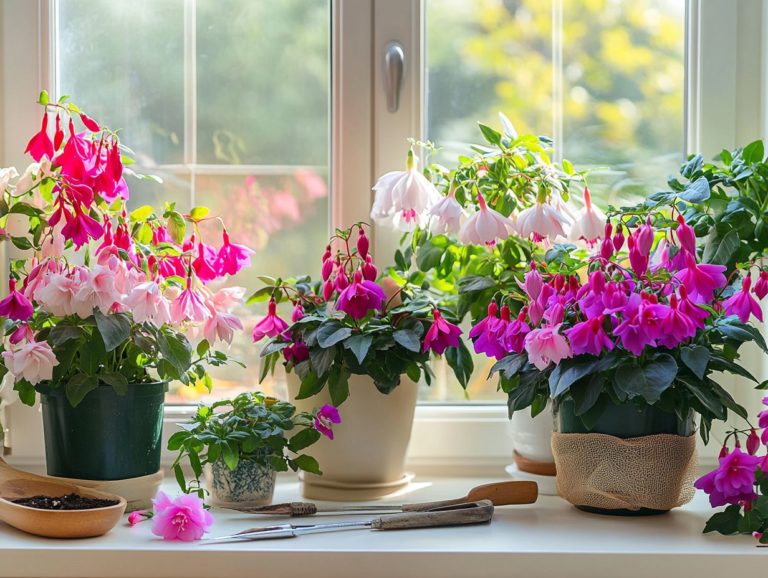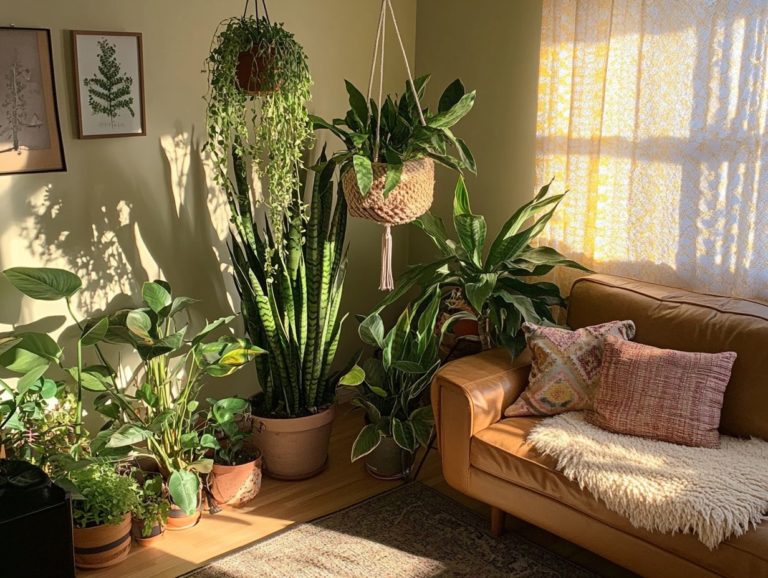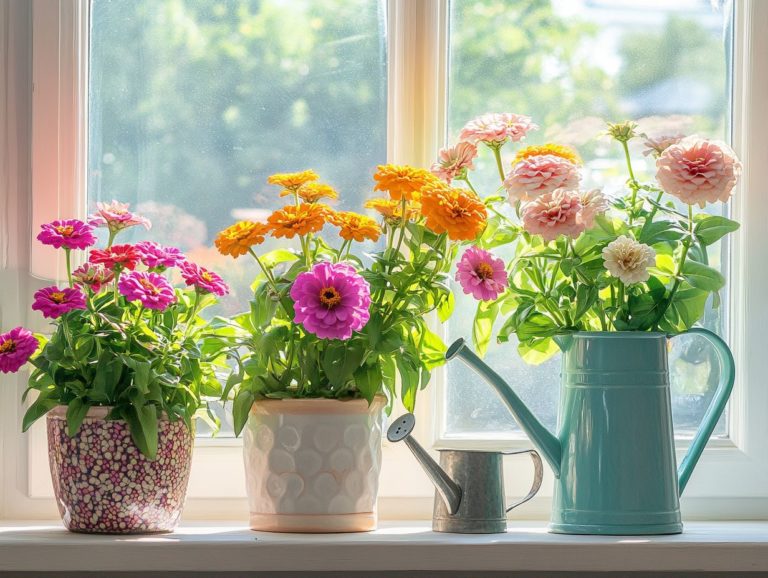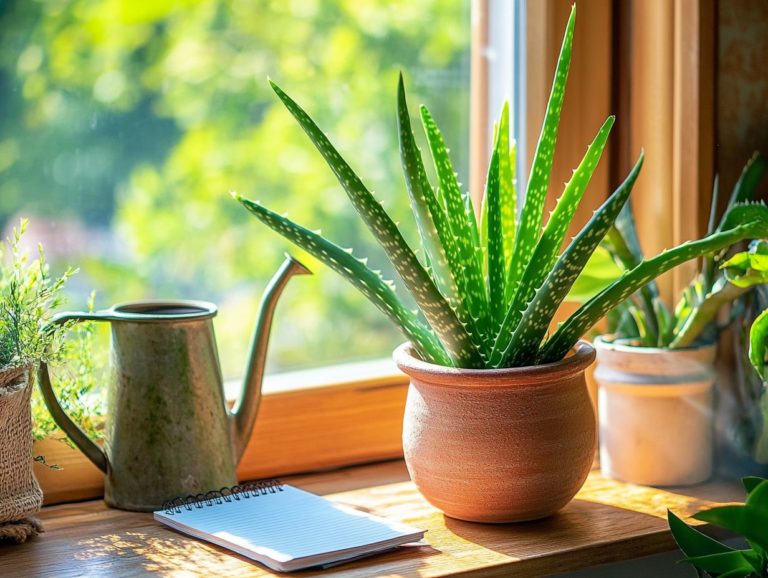Caring for Indoor Citrus Trees: A Guide
Growing citrus trees indoors can be an immensely rewarding endeavor, bringing fragrant blooms and delectable fruits right to your fingertips. By employing effective care practices, you can enjoy the benefits of indoor gardening.
This guide assists you in choosing the ideal citrus tree for your space. You’ll gain insights into proper care, including watering, fertilizing, and pruning, while also addressing common challenges you may encounter.
Discover the best practices for harvesting and explore innovative ways to utilize your citrus bounty. Embrace the joys of indoor citrus gardening and savor the freshness it adds to your life!
Contents
- Key Takeaways:
- Choosing the Right Citrus Tree
- Want to grow healthy indoor citrus trees? It s all about blending the right techniques.
- Harvesting and Using Citrus Fruits
- Common Issues and Troubleshooting
- Frequently Asked Questions
- What are some tips for caring for indoor citrus trees?
- How often should I water my indoor citrus tree?
- Can I use regular soil for my indoor citrus tree?
- When is the best time to fertilize my indoor citrus tree?
- When is the best time to fertilize my indoor citrus tree?
- How can I prevent pests and diseases on my indoor citrus tree?
- What can I do if my indoor citrus tree drops its leaves?
- What are some tips for caring for indoor citrus trees?
- How often should I water my indoor citrus tree?
- Can I use regular soil for my indoor citrus tree?
Key Takeaways:
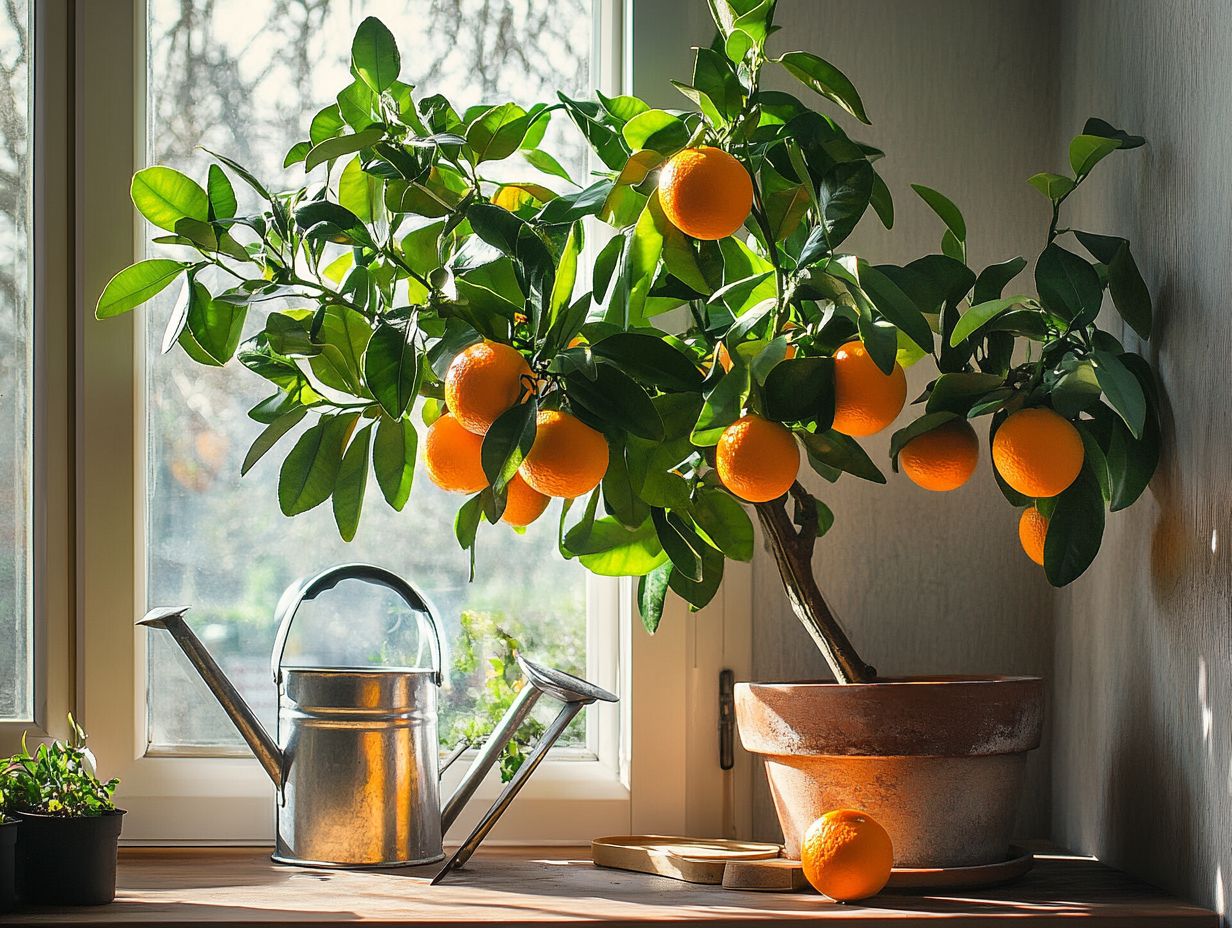
- Choose the right citrus tree by considering factors such as space, light, and variety.
- Care for indoor citrus trees by properly watering, fertilizing, pruning, and controlling pests.
- Harvest and use citrus fruits by knowing when and how to harvest, and exploring various ways to incorporate them into meals and home remedies.
Benefits of Growing Citrus Trees Indoors
Growing citrus trees indoors offers a wealth of benefits, making your home more lively while enhancing air quality with delightful essential oils. Imagine having Meyer lemons, Calamondin oranges, and Bearss limes that not only beautify your space but also contribute to your culinary adventures.
These indoor citrus trees can elevate your emotional well-being and provide an engaging hobby that connects you with nature. They are a perfect choice for enthusiastic indoor gardeners and lifestyle aficionados alike.
Nurturing these exquisite plants fosters a deeper appreciation for nature while adding a splash of color and fragrance to any room. Experts like Arricca Elin SanSone showcase how these trees thrive indoors, infusing both beauty and functionality into your home garden.
By incorporating these lively plants into your daily routine, you can cultivate a holistic lifestyle that celebrates well-being and sustainability.
Choosing the Right Citrus Tree
Choosing the perfect citrus tree for your indoor garden is essential for creating a rewarding and pleasurable experience. Your selection be it a Meyer lemon, Calamondin orange, Bearss lime, or Trovita orange should align with key factors such as light, humidity, and your personal taste.
With the right tree in place, you can cultivate an aromatic and productive indoor garden by following expert advice and best practices for container gardening from reputable sources.
Factors to Consider
When selecting an indoor citrus tree, several critical factors demand your attention to ensure successful growth and fruiting. Consider optimal light exposure, humidity levels, proper drainage to prevent waterlogging, and healthy soil conditions these are vital for the overall well-being of your citrus plants.
Providing ample sunlight ideally 10 to 14 hours of bright, indirect light is crucial for photosynthesis and flower development. Maintaining humidity levels around 50-70% helps recreate the tree’s native subtropical environment, encouraging robust growth.
The significance of proper drainage cannot be overstated; well-draining pots and soil mixes prevent water accumulation, allowing roots to breathe. Choosing nutrient-rich, pH-balanced soil supports optimal health, leading to vibrant foliage and productive fruiting.
Together, these factors create the ideal atmosphere for your indoor citrus plants to flourish and thrive.
Want to grow healthy indoor citrus trees? It s all about blending the right techniques.
Caring for indoor citrus trees requires a thoughtful blend of techniques designed to foster healthy growth and fruit production. You ll find that proper watering, fertilization, and pruning are crucial to their care, alongside effective pest control strategies to shield against common pests.
By grasping these key elements, you can cultivate a thriving environment for your citrus trees, allowing them to flourish while also releasing delightful essential oils that elevate your indoor air quality.
Watering and Fertilizing
Effective watering and fertilizing are crucial elements in caring for your citrus trees, directly impacting their health and productivity. Citrus trees thrive on a specific watering schedule that balances moisture and drainage. This prevents root rot and ensures they receive essential nutrients through organic fertilizers. Understanding the nutritional needs of your citrus trees is vital for fostering healthy growth and lots of fruit.
To maintain this balance, take a moment to assess the soil’s moisture level before watering; ideally, you should allow the top inch of soil to dry out between waterings. Keep an eye out for signs of overwatering, such as yellowing leaves or a perpetually soggy soil, while underwatering might manifest as wilting or browning leaves.
Using organic fertilizers like compost or fish emulsion can enrich your soil without the downsides of synthetic alternatives, providing your roots with key nutrients such as nitrogen, phosphorus, and potassium. Regularly checking the soil pH (which measures how acidic or alkaline your soil is) and drainage will help further enhance overall soil health, creating the perfect environment for your citrus trees to flourish.
Pruning and Pest Control
Pruning and pest control are essential for keeping your indoor citrus trees thriving and productive throughout their growth cycles. Regular pruning does more than just shape your tree; it enhances air circulation and maximizes light exposure. Coupled with effective pest control strategies particularly organic ones you can prevent and manage infestations from common plant pests.
To truly unlock the growth potential of your trees, establish a regular pruning schedule. This involves trimming away dead or overcrowded branches and thinning the canopy to let sunlight in, leading to healthier leaves and a more bountiful fruit harvest.
Embracing organic pest management techniques elevates your gardening experience. Consider methods like:
- Introducing beneficial insects such as ladybugs,
- Applying neem oil,
- Using insecticidal soap.
These approaches can effectively ward off unwanted pests without harming your plants or the environment. For those passionate about indoor gardening, these expert tips not only boost the vitality of your citrus trees but also provide the comfort of knowing your practices are eco-friendly.
Harvesting and Using Citrus Fruits
Harvesting citrus fruits from your indoor trees is a truly rewarding experience, enabling you to relish the fruits of your labor in countless culinary applications.
Imagine the sweet flavor of Meyer lemons, the delightful tartness of Calamondin oranges, or the zesty brightness of Bearss limes and Trovita oranges all offering a wealth of possibilities for creating delicious dishes and refreshing beverages.
These vibrant fruits also provide essential oils, enhancing the ambiance of your home in a way that is both fragrant and uplifting. Try using your fresh lemons to whip up a zesty lemonade!
When and How to Harvest
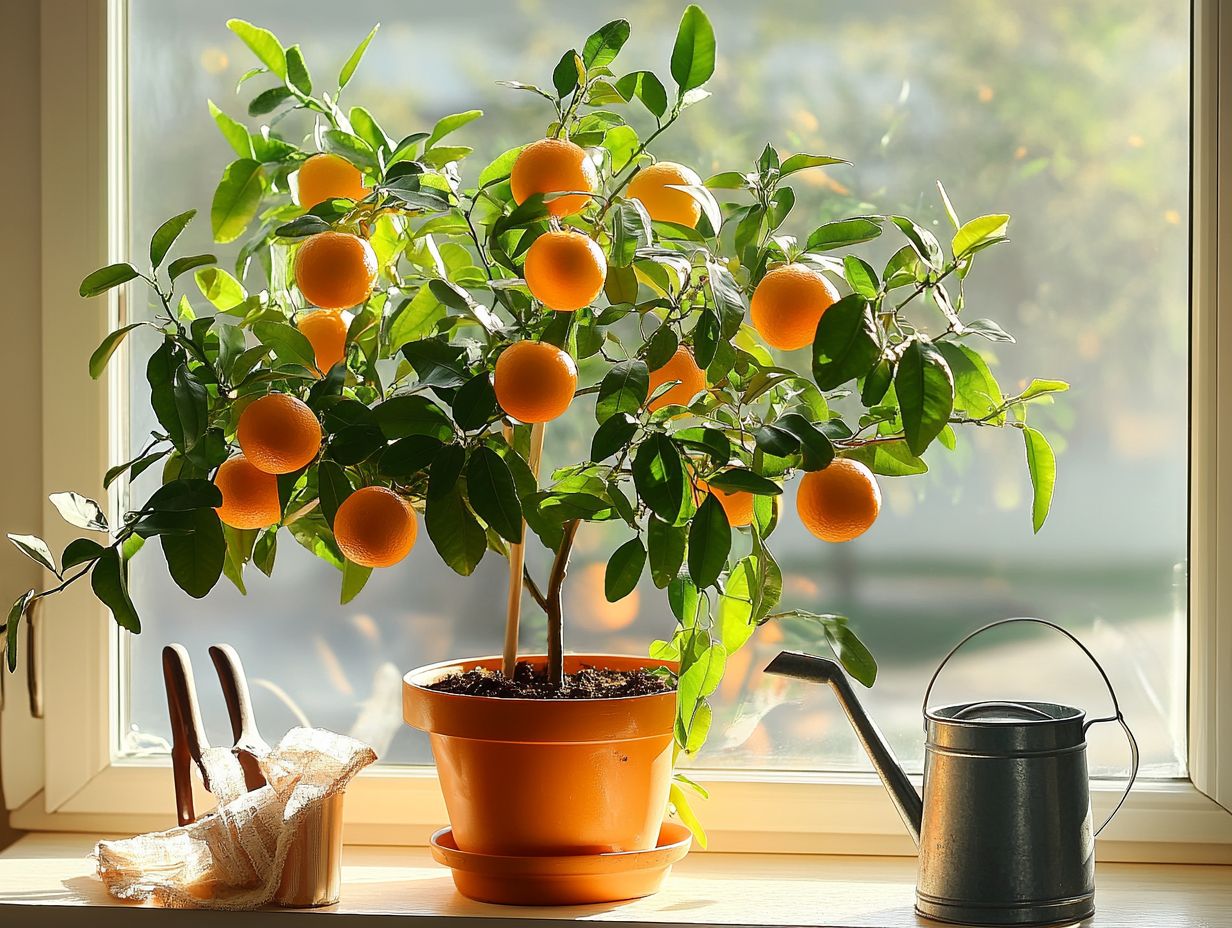
Knowing when and how to harvest citrus fruits is crucial for maximizing flavor and quality. Each variety Meyer lemon, Calamondin orange, Bearss lime, or Trovita orange has its unique harvest window, typically aligned with seasonal growth patterns. Understand these timings to ensure your indoor citrus delivers exquisite taste and nutritional benefits.
To determine ripeness, look for vibrant colors and a slight softness when you gently squeeze the fruit; these signs indicate that it s ready for picking. For instance, Meyer lemons should achieve a deep yellow hue, while Bearss limes may display a hint of yellow. Timing is everything harvest in the late afternoon when the fruit is fully developed and the sugars are at their peak.
In indoor gardening, using the right soil suitable for pots and ensuring adequate light can significantly influence fruit quality. Keep an eye on these factors, and you can enjoy a bountiful citrus harvest throughout the year.
Ways to Use Citrus Fruits
Citrus fruits are remarkably versatile, ready to elevate a myriad of culinary creations with their vibrant flavors and enticing aromas. Picture this: Meyer lemons brightening up your desserts, Calamondin oranges adding a zesty twist to marinades, or Bearss limes transforming your cocktails into something extraordinary. The potential for incorporating these fruits into your cooking and baking is virtually limitless.
- Use grapefruit to elevate a fresh salad.
- Infuse blood oranges into a savory sauce for roasted meats.
- Utilize citrus zest to enhance baked goods.
- Incorporate citrus juices for refreshing dressings and dips.
Beyond the culinary realm, the invigorating scents of citrus, like bergamot or orange blossom, can uplift your mood and create a sense of relaxation during your self-care rituals. Explore these diverse options to infuse your daily meals and living spaces with the joy and health benefits that citrus fruits offer.
Common Issues and Troubleshooting
Understanding common issues and effective troubleshooting techniques is essential for successfully cultivating indoor citrus trees. These exquisite plants can be vulnerable to a range of diseases and pests that jeopardize their health and productivity.
For instance, root rot frequently arises from poor drainage for citrus and insufficient humidity for citrus levels. By recognizing symptoms early and implementing effective solutions, you can protect your citrus trees and ensure they thrive in your indoor oasis. Additionally, if you’re interested in caring for other plants, consider exploring caring for indoor peperomias for more tips and guidance.
Identifying and Addressing Problems
Start by recognizing the signs of diseases and pests in your citrus trees. Look out for yellowing leaves, wilting, or visible pests this often means there’s a problem like root rot or low humidity.
Keep an eye out for pests like aphids or spider mites, which appear as tiny specks or webbing. Regularly check your watering routine and ensure the soil is well-drained to prevent these issues.
If you spot a pest infestation, a simple mix of neem oil and water can be an effective organic pesticide. You should also increase humidity levels around your trees to keep them happy and healthy.
Make it a habit to check your plants regularly and keep the area clean. Remove fallen leaves and debris to maintain a clean environment for your indoor citrus trees.
By taking these steps and focusing on proper plant nutrition, you can grow vibrant trees that reward you with delicious fruit. If you’re also interested in indoor plants, consider referring to this guide to caring for indoor eucalyptus. Don’t wait too long to act—your citrus trees depend on you!
Tips for Long-Term Success
For long-term success in cultivating indoor citrus trees, you must embrace a holistic approach to plant care. This means ensuring enough sunlight, humidity levels, and regularly applying organic fertilizer, all while keeping an eye out for any issues that may arise. By creating a nurturing environment, you’ll enjoy a bountiful harvest!
Establishing a balanced ecosystem around these vibrant plants not only boosts their growth but also helps you tackle the challenges posed by pests and diseases. Regular monitoring of soil moisture and engaging in periodic pruning will further enhance their health, allowing for improved air circulation and light penetration.
Remember, every detail is crucial from selecting the right potting mix to staying vigilant against common indoor pests. By weaving these strategies into your care routine, you can cultivate thriving citrus trees and derive joy from watching them flourish, ultimately reaping bountiful yields of fruit indoors.
Key practices include:
- Choose high-quality potting soil for best results
- Ensure proper drainage for citrus
- Use neem oil as a natural insect repellent
With a blend of these practices, you can elevate your indoor gardening experience to new heights.
Frequently Asked Questions
What are some tips for caring for indoor citrus trees?
Some tips for caring for indoor citrus trees include providing adequate sunlight exposure, regular watering, proper fertilization, and monitoring for pests and diseases.
How often should I water my indoor citrus tree?

The frequency of watering will depend on factors such as the size of the tree, type of pot, and environmental conditions. In general, water your citrus tree when the top inch of soil feels dry.
Can I use regular soil for my indoor citrus tree?
No, regular soil is not suitable for indoor citrus trees. They require well-draining soil with a slightly acidic pH. It is best to use a potting mix specifically designed for citrus trees.
When is the best time to fertilize my indoor citrus tree?
Start your indoor citrus journey today and watch your plants thrive!
When is the best time to fertilize my indoor citrus tree?
The best time to fertilize indoor citrus trees is during the growing season, which is typically in the spring and summer. Use a citrus-specific fertilizer according to the instructions on the package.
How can I prevent pests and diseases on my indoor citrus tree?
Check your tree often for pests and diseases. Avoid overwatering and ensure good air circulation around the plant. If you find pests, try using organic methods or ask an expert for help!
What can I do if my indoor citrus tree drops its leaves?
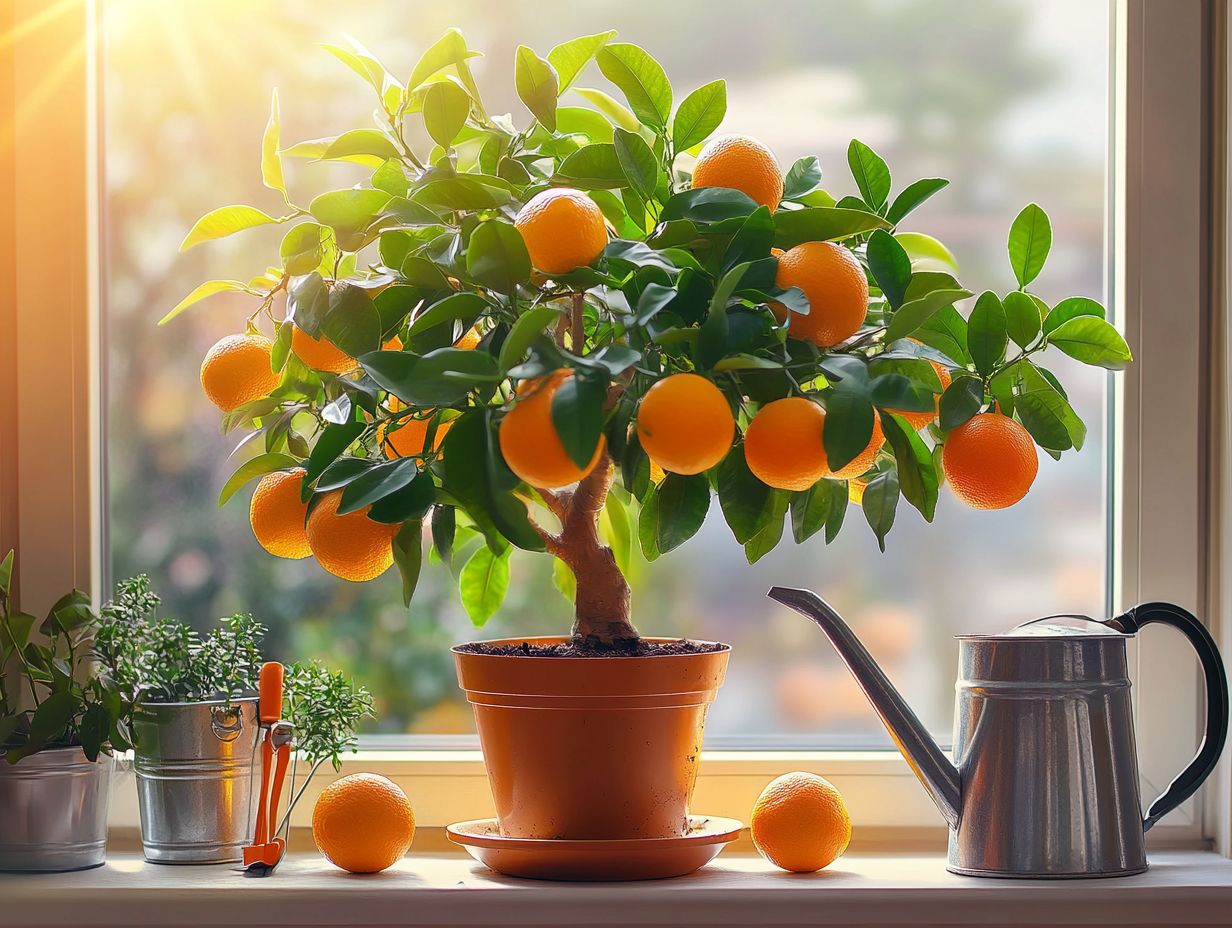
If your indoor citrus tree drops its leaves, it could be a sign of overwatering, underwatering, or a pest infestation. Check the soil moisture and inspect the tree for any pests. Adjust watering and treat any pests accordingly.
What are some tips for caring for indoor citrus trees?
Provide adequate sunlight for your indoor citrus tree. Regular watering, proper fertilization, and monitoring for pests and diseases are also essential.
How often should I water my indoor citrus tree?
The frequency of watering depends on factors like the size of the tree, type of pot, and environmental conditions. In general, citrus trees should be watered when the top inch of soil feels dry.
Can I use regular soil for my indoor citrus tree?
No, regular soil is not suitable for indoor citrus trees. They require well-draining soil with a slightly acidic pH. It is best to use a potting mix specifically designed for citrus trees.

